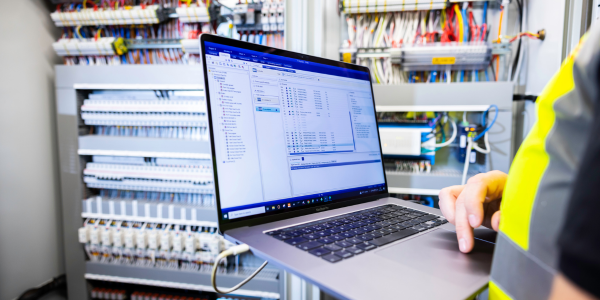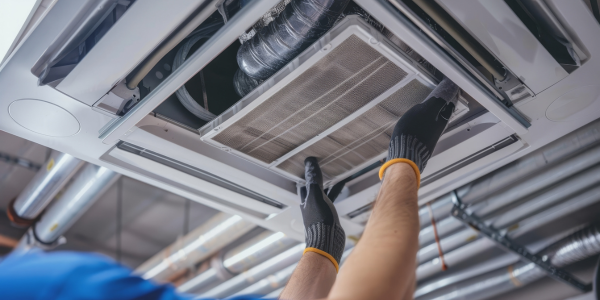Imagine a building that can adjust its temperature, lighting and even security based on your needs, all while saving energy and reducing costs. Welcome to the world of smart buildings, where technology and innovation converge to create spaces that are not only more efficient but also more comfortable and sustainable. In this blog, we’ll explain how smart buildings are transforming the way we live and work, from cutting-edge technologies to real-world examples, showing how these buildings are shaping the future of urban living and working.
What is a smart building?
A smart building is defined by its use of interconnected systems and automation to optimise energy efficiency, comfort and functionality. These buildings leverage sensors, IoT (Internet of Things) devices, data analytics and AI (Artificial Intelligence) to monitor and control a range of components, such as lighting, HVAC, security and even water usage. By intelligently adapting to occupants’ needs and external conditions, smart buildings enhance operational efficiency while reducing costs and environmental impact.
Smart buildings play an increasingly essential role in improving energy efficiency. They provide enhanced safety, convenience and productivity for occupants through advanced features like automated temperature control and security alerts. Smart buildings also support remote management, making them ideal for modern, flexible work environments. As cities grow and resources become scarce, smart buildings are key to sustainable urban development.
What are the main differences between smart buildings, BEMS and BAS?
Smart buildings, Building Energy Management Systems (BEMS), and Building Automation Systems (BAS) all focus on improving building operations but differ in scope and technology:
Smart buildings use advanced technologies to integrate and optimise multiple systems, including energy, security, HVAC and lighting, offering a holistic approach to efficiency and user experience.
BEMS, on the other hand, are specialised systems focused exclusively on energy usage. They monitor, analyse and control energy consumption in buildings to reduce costs and environmental impact, often forming part of a larger smart building framework.
BAS refers to systems that automate specific mechanical and electrical operations, such as HVAC, lighting or elevators. Unlike smart buildings, BAS typically lack AI or IoT integration, offering automation but not predictive insights or broader connectivity.
What are smart building technologies?
Smart building technologies are tools and systems that make buildings more efficient, comfortable and sustainable by automating and optimising various operations.
Key technologies include:
- Smart sensors – monitor energy use, lighting and occupancy, enabling automated adjustments to save energy. For example, smart thermostats adjust heating and cooling based on occupancy.
- IoT devices – connect building systems, allowing seamless communication between HVAC, lighting and security systems
- AI and Machine Learning (ML) – smart building energy management systems using machine learning can analyse data to predict maintenance needs, optimise energy use and enhance safety. Examples include using AI for facial recognition and anomaly detection.
These technologies collectively make smart buildings more sustainable, cost-effective and convenient for users.
Real-world applications of smart building technologies
Smart buildings are no longer a concept of the future. Smart building technologies are being integrated into key structures we encounter daily. Notable examples include The Edge in Amsterdam and Bloomberg’s London Headquarters.
The Edge, Amsterdam
The Edge, which has been called the ‘smartest building in the world’, uses thousands of IoT sensors to monitor lighting, temperature and occupancy. These sensors optimise energy efficiency and customise workspaces based on employees’ schedules. Its lighting system is powered by PoE (Power over Ethernet) technology, delivering both electrical power and data over a single copper Ethernet cable, simplifying installations for devices like cameras, sensors and access points. This method has proven to be highly energy-efficient, while AI is used to integrate data to enhance building performance and user experience.
Bloomberg HQ, London
Bloomberg’s European HQ, purportedly the ‘World’s Most Sustainable Office Building’ when it was conceived in 2017, is LEED-certified with an ‘Outstanding’ BREEM rating. It integrates smart energy systems with CO2 sensors to control and distribute airflow according to the approximate number of people occupying each zone of the building. This can save up to 600-750 MWhr of power each year, reducing CO2 emissions by approximately 300 metric tonnes. The building also features rainwater harvesting systems, including recycling ‘grey water’ from sinks and showers to supply the vacuum toilets.
Smart buildings harness technology to tackle natural disasters
Smart buildings can also use these advanced technologies to respond and adjust to force majeure events, enhancing resilience and safety.
Flooding: IoT sensors monitor water levels around the building and can trigger automatic actions, such as activating drainage systems, closing water valves or redirecting power to emergency pumps. AI-driven systems analyse weather forecasts and historical data to predict potential flood risks, allowing the building to prepare in advance by adjusting its HVAC, lighting or even adjusting structural elements like flood barriers.
Earthquakes: Motion sensors detect ground shifts and activate emergency protocols, such as locking down elevators, adjusting HVAC systems and guiding occupants to safe areas using smart signage (i.e. dynamic digital displays that provide real-time, context-aware information). Additionally, structural health monitoring systems use sensors to continuously assess building integrity, providing real-time feedback to ensure the structure remains safe after seismic activity.
These technologies allow smart buildings to mitigate the impact of such disasters, ensuring occupant safety and minimising damage.
Advantages of smart buildings
Cutting costs and maximising efficiency
Smart buildings are designed to significantly reduce operating costs. With energy-efficient systems, such as AI-powered HVAC and lighting, they lower energy consumption by 20 to 73%, directly reducing energy bills. But in addition to this, using advanced monitoring systems offers real-time insights into building performance, which can help lower insurance premiums by minimising risks and improving safety. AI-powered predictive maintenance can also identify issues early, extending the life of expensive systems like HVAC and elevators, potentially saving millions over decades.
ROI that goes beyond energy savings
Studies have shown that improving air quality and lighting in workplaces can boost employee productivity by as much as 15%. With smart air systems, buildings can monitor and reduce allergens, carbon dioxide levels and track indoor pollution, creating a healthier environment. This not only leads to a more comfortable and productive workspace but can also reduce absenteeism and improve overall employee well-being. The improved working conditions offer substantial value that enhances the long-term ROI of smart buildings.
Smart buildings are reshaping the way we live and work
By integrating IoT, AI and machine learning, smart buildings not only optimise day-to-day operations, but also respond dynamically to challenges such as natural disasters, enhancing safety and resilience. The financial benefits of smart buildings are clear, from significant energy savings to extended equipment lifespans and reduced insurance premiums. Beyond this, buildings using smart technology contribute to better air quality and increased productivity. As cities evolve, smart buildings will play a key role in shaping sustainable, cost-effective urban environments.
Cube Controls is an established and experienced supplier of Building Management Systems, specialising in the design and set up of bespoke environmental and energy control programmes for commercial buildings and property.
To find out how Cube Controls can support you at all stages of design and consultancy, installation and modification and maintenance of your building management systems contact our expert and friendly team on 01903 694279 or sales@cubecontrols.co.uk.




